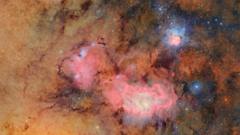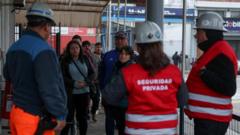The Vera Rubin Observatory in Chile has made a monumental leap in astronomical observation by releasing its first stunning images, showcasing the intricate beauty of the Trifid and Lagoon nebulae. Located 9,000 light years from Earth, these vibrant gas and dust clouds represent just a fraction of the incredible discoveries this powerful telescope will enable in the coming years.
Unveiling the Universe: First Images from Vera Rubin Telescope Released

Unveiling the Universe: First Images from Vera Rubin Telescope Released
The groundbreaking Vera Rubin Telescope in Chile has captured its first celestial images, promising to revolutionize our understanding of the universe.
The observatory, equipped with the world's most advanced 3,200-megapixel digital camera, is set to transform our knowledge of the cosmos over a continuous ten-year survey of the southern night sky. With capabilities to uncover previously unknown celestial bodies—including a potential ninth planet in our solar system—and detect dangerous asteroids, the telescope promises to bring both new understanding and enhanced safety to Earth.
Elana Urbach, one of the commissioning scientists, emphasizes the importance of high-quality images for understanding the universe’s history. The observatory's precision mirrors are key to capturing data that will enable scientists to explore galaxies and supernovae dating back billions of years.
The vast amount of data generated will reach up to 10 million alerts per night, significantly enhancing our knowledge of the Milky Way and the broader universe. The continuous nature of this survey is particularly significant, as it allows for repeated observations of the same areas, enabling scientists to detect and analyze transient objects and movements in the night sky.
The excitement surrounding the first image release marks a momentous occasion in astronomy, with researchers worldwide eager to analyze the data and potentially address longstanding mysteries, such as the existence of Planet Nine. As Professor Catherine Heymans puts it, the promise of the Vera Rubin Observatory is profound, and the journey to fully comprehend this innovative facility has just begun.
Elana Urbach, one of the commissioning scientists, emphasizes the importance of high-quality images for understanding the universe’s history. The observatory's precision mirrors are key to capturing data that will enable scientists to explore galaxies and supernovae dating back billions of years.
The vast amount of data generated will reach up to 10 million alerts per night, significantly enhancing our knowledge of the Milky Way and the broader universe. The continuous nature of this survey is particularly significant, as it allows for repeated observations of the same areas, enabling scientists to detect and analyze transient objects and movements in the night sky.
The excitement surrounding the first image release marks a momentous occasion in astronomy, with researchers worldwide eager to analyze the data and potentially address longstanding mysteries, such as the existence of Planet Nine. As Professor Catherine Heymans puts it, the promise of the Vera Rubin Observatory is profound, and the journey to fully comprehend this innovative facility has just begun.
















